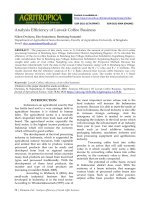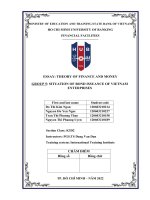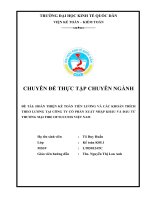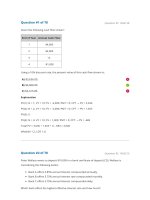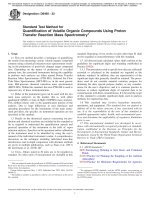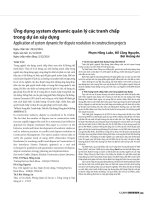- Trang chủ >>
- Khoa Học Tự Nhiên >>
- Vật lý
Physical models of living systems
Bạn đang xem bản rút gọn của tài liệu. Xem và tải ngay bản đầy đủ của tài liệu tại đây (16.14 MB, 365 trang )
“main”
page i
Physical Models of Living Systems
Philip Nelson
University of Pennsylvania
with the assistance of Sarina Bromberg,
Ann Hermundstad, and Jason Prentice
W. H. Freeman and Company
New York
“main”
page ii
Publisher: Kate Parker
Acquisitions Editor: Alicia Brady
Senior Development Editor: Blythe Robbins
Assistant Editor: Courtney Lyons
Editorial Assistant: Nandini Ahuja
Marketing Manager: Taryn Burns
Senior Media and Supplements Editor: Amy Thorne
Director of Editing, Design, and Media Production: Tracey Kuehn
Managing Editor: Lisa Kinne
Project Editor: Kerry O’Shaughnessy
Production Manager: Susan Wein
Design Manager and Cover Designer: Vicki Tomaselli
Illustration Coordinator: Matt McAdams
Photo Editors: Christine Buese, Richard Fox
Composition: codeMantra
Printing and Binding: RR Donnelley
Cover: [Two-color, superresolution optical micrograph.] Two specific structures in a mammalian cell
have been tagged with fluorescent molecules via immunostaining: microtubules (false-colored green)
and clathrin-coated pits, cellular structures used for receptor-mediated endocytosis (false-colored
red). See also Figure 6.5 (page 138). The magnification is such that the height of the letter “o” in
the title corresponds to about 1.4 µm. [Image courtesy Mark Bates, Dept. of NanoBiophotonics, Max
Planck Institute for Biophysical Chemistry, published in Bates et al., 2007. Reprinted with permission
from AAAS.] Inset: The equation known today as the “Bayes formula” first appeared in recognizable
form around 1812, in the work of Pierre Simon de Laplace. In our notation, the formula appears as
Equation 3.17 (page 52) with Equation 3.18. (The letter “S” in Laplace’s original formulation is an
obsolete notation for sum, now written as .) This formula forms the basis of statistical inference,
including that used in superresolution microscopy.
Title page: Illustration from James Watt’s patent application. The green box encloses a centrifugal
governor. [From A treatise on the steam engine: Historical, practical, and descriptive (1827) by John
Farey.]
Library of Congress Preassigned Control Number: 2014949574
ISBN-13: 978-1-4641-4029-7
ISBN-10: 1-4641-4029-4
©2015 by Philip C. Nelson
All rights reserved
Printed in the United States of America
First printing
W. H. Freeman and Company, 41 Madison Avenue, New York, NY 10010
Houndmills, Basingstoke RG21 6XS, England
www.whfreeman.com
“main”
page iii
For my classmates Janice Enagonio, Feng Shechao, and Andrew Lange.
“main”
page iv
Whose dwelling is the light of setting suns,
And the round ocean and the living air,
And the blue sky, and in the mind of man:
A motion and a spirit, that impels
All thinking things, all objects of all thought,
And rolls through all things.
– William Wordsworth
“main”
page v
Brief Contents
Prolog: A breakthrough on HIV
PART I
First Steps
Chapter 1
Virus Dynamics
Chapter 2
Physics and Biology
PART II
1
9
27
Randomness in Biology
Chapter 3
Discrete Randomness
35
Chapter 4
Some Useful Discrete Distributions
69
Chapter 5
Continuous Distributions
97
Chapter 6
Model Selection and Parameter Estimation
123
Chapter 7
Poisson Processes
153
Jump to Contents Jump to Index
v
“main”
vi
page vi
Brief Contents
PART III Control in Cells
Chapter 8
Randomness in Cellular Processes
179
Chapter 9
Negative Feedback Control
203
Chapter 10 Genetic Switches in Cells
241
Chapter 11 Cellular Oscillators
277
Epilog
299
Appendix A Global List of Symbols
303
Appendix B Units and Dimensional Analysis
309
Appendix C Numerical Values
315
Jump to Contents Jump to Index
Acknowledgments
317
Credits
321
Bibliography
323
Index
333
“main”
page vii
Detailed Contents
Web Resources xvii
To the Student xix
To the Instructor xxiii
Prolog: A breakthrough on HIV
PART I
Chapter 1
1
First Steps
9
Virus Dynamics
1.1
1.2
First Signpost 9
Modeling the Course of HIV Infection 10
1.2.1 Biological background 10
1.2.2 An appropriate graphical representation can bring
out key features of data 12
1.2.3 Physical modeling begins by identifying the key actors and
their main interactions 12
1.2.4 Mathematical analysis yields a family of predicted
behaviors 14
1.2.5 Most models must be fitted to data 15
1.2.6 Overconstraint versus overfitting 17
1.3 Just a Few Words About Modeling 17
Key Formulas 19
Track 2 21
1.2.4′
Exit from the latency period 21
1.2.6′ a
Informal criterion for a falsifiable prediction 21
Jump to Contents Jump to Index
vii
“main”
viii
page viii
Detailed Contents
1.2.6′ b
More realistic viral dynamics models
1.2.6′ c
Eradication of HIV 22
Problems 23
Chapter 2
21
Physics and Biology
27
2.1 Signpost 27
2.2 The Intersection 28
2.3 Dimensional Analysis 29
Key Formulas 30
Problems 31
PART II Randomness in Biology
Chapter 3
Discrete Randomness
3.1
3.2
Signpost 35
Avatars of Randomness 36
3.2.1 Five iconic examples illustrate the concept of randomness 36
3.2.2 Computer simulation of a random system 40
3.2.3 Biological and biochemical examples 40
3.2.4 False patterns: Clusters in epidemiology 41
3.3 Probability Distribution of a Discrete Random System 41
3.3.1 A probability distribution describes to what extent a random
system is, and is not, predictable 41
3.3.2 A random variable has a sample space with numerical
meaning 43
3.3.3 The addition rule 44
3.3.4 The negation rule 44
3.4 Conditional Probability 45
3.4.1 Independent events and the product rule 45
3.4.1.1 Crib death and the prosecutor’s fallacy 47
3.4.1.2 The Geometric distribution describes the waiting
times for success in a series of independent trials 47
3.4.2 Joint distributions 48
3.4.3 The proper interpretation of medical tests requires an
understanding of conditional probability 50
3.4.4 The Bayes formula streamlines calculations involving
conditional probability 52
3.5 Expectations and Moments 53
3.5.1 The expectation expresses the average of a random variable
over many trials 53
3.5.2 The variance of a random variable is one measure of its
fluctuation 54
3.5.3 The standard error of the mean improves with increasing
sample size 57
Key Formulas 58
Track 2 60
Jump to Contents Jump to Index
35
‘‘main’’
page ix
Detailed Contents
3.4.1′ a
3.4.1′ b
3.4.1′ c
3.4.4′
3.5.2′ a
3.5.2′ b
3.5.2′ c
Problems 63
Chapter 4
Extended negation rule 60
Extended product rule 60
Extended independence property 60
Generalized Bayes formula 60
Skewness and kurtosis 60
Correlation and covariance 61
Limitations of the correlation coefficient
ix
62
69
Some Useful Discrete Distributions
4.1
4.2
Signpost 69
Binomial Distribution 70
4.2.1 Drawing a sample from solution can be modeled in terms of
Bernoulli trials 70
4.2.2 The sum of several Bernoulli trials follows a Binomial
distribution 71
4.2.3 Expectation and variance 72
4.2.4 How to count the number of fluorescent molecules in a
cell 72
4.2.5 Computer simulation 73
4.3 Poisson Distribution 74
4.3.1 The Binomial distribution becomes simpler in the limit of
sampling from an infinite reservoir 74
4.3.2 The sum of many Bernoulli trials, each with low probability,
follows a Poisson distribution 75
4.3.3 Computer simulation 78
4.3.4 Determination of single ion-channel conductance 78
4.3.5 The Poisson distribution behaves simply under
convolution 79
4.4 The Jackpot Distribution and Bacterial Genetics 81
4.4.1 It matters 81
4.4.2 Unreproducible experimental data may nevertheless contain an
important message 81
4.4.3 Two models for the emergence of resistance 83
4.4.4 The Luria-Delbrück hypothesis makes testable predictions for
the distribution of survivor counts 84
4.4.5 Perspective 86
Key Formulas 87
Track 2 89
4.4.2′
On resistance 89
′
4.4.3
More about the Luria-Delbrück experiment 89
4.4.5′ a
Analytical approaches to the Luria-Delbrück
calculation 89
′
4.4.5 b
Other genetic mechanisms 89
4.4.5′ c
Non-genetic mechanisms 90
4.4.5′ d
Direct confirmation of the Luria-Delbrück hypothesis 90
Problems 91
Jump to Contents Jump to Index
“main”
x
page x
Detailed Contents
Chapter 5
97
Continuous Distributions
5.1
5.2
Signpost 97
Probability Density Function 98
5.2.1 The definition of a probability distribution must be modified
for the case of a continuous random variable 98
5.2.2 Three key examples: Uniform, Gaussian, and Cauchy
distributions 99
5.2.3 Joint distributions of continuous random variables 101
5.2.4 Expectation and variance of the example distributions 102
5.2.5 Transformation of a probability density function 104
5.2.6 Computer simulation 106
5.3 More About the Gaussian Distribution 106
5.3.1 The Gaussian distribution arises as a limit of Binomial 106
5.3.2 The central limit theorem explains the ubiquity of Gaussian
distributions 108
5.3.3 When to use/not use a Gaussian 109
5.4 More on Long-tail Distributions 110
Key Formulas 112
Track 2 114
5.2.1′
Notation used in mathematical literature 114
5.2.4′
Interquartile range 114
′
5.4 a
Terminology 115
5.4′ b
The movements of stock prices 115
Problems 118
Chapter 6
Model Selection and Parameter Estimation
6.1
6.2
6.3
6.4
Jump to Contents Jump to Index
123
Signpost 123
Maximum Likelihood 124
6.2.1 How good is your model? 124
6.2.2 Decisions in an uncertain world 125
6.2.3 The Bayes formula gives a consistent approach to updating our
degree of belief in the light of new data 126
6.2.4 A pragmatic approach to likelihood 127
Parameter Estimation 128
6.3.1 Intuition 129
6.3.2 The maximally likely value for a model parameter can be
computed on the basis of a finite dataset 129
6.3.3 The credible interval expresses a range of parameter values
consistent with the available data 130
6.3.4 Summary 132
Biological Applications 133
6.4.1 Likelihood analysis of the Luria-Delbrück experiment 133
6.4.2 Superresolution microscopy 133
6.4.2.1 On seeing 133
6.4.2.2 Fluorescence imaging at one nanometer
accuracy 133
“main”
page xi
Detailed Contents
xi
6.4.2.3
Localization microscopy:
PALM/FPALM/STORM 136
6.5 An Extension of Maximum Likelihood Lets Us Infer Functional
Relationships from Data 137
Key Formulas 141
Track 2 142
6.2.1′
Cross-validation 142
6.2.4′ a
Binning data reduces its information content 142
6.2.4′ b
Odds 143
6.3.2′ a
The role of idealized distribution functions 143
6.3.2′ b
Improved estimator 144
6.3.3′ a
Credible interval for the expectation of
Gaussian-distributed data 144
6.3.3′ b
Confidence intervals in classical statistics 145
6.3.3′ c
Asymmetric and multivariate credible intervals 146
6.4.2.2′
More about FIONA 146
′
6.4.2.3
More about superresolution 147
6.5′
What to do when data points are correlated 147
Problems 149
Chapter 7
Poisson Processes
7.1
7.2
7.3
7.4
7.5
7.6
153
Signpost 153
The Kinetics of a Single-Molecule Machine 153
Random Processes 155
7.3.1 Geometric distribution revisited 156
7.3.2 A Poisson process can be defined as a continuous-time limit of
repeated Bernoulli trials 157
7.3.2.1 Continuous waiting times are Exponentially
distributed 158
7.3.2.2 Distribution of counts 160
7.3.3 Useful Properties of Poisson processes 161
7.3.3.1 Thinning property 161
7.3.3.2 Merging property 161
7.3.3.3 Significance of thinning and merging
properties 163
More Examples 164
7.4.1 Enzyme turnover at low concentration 164
7.4.2 Neurotransmitter release 164
Convolution and Multistage Processes 165
7.5.1 Myosin-V is a processive molecular motor whose stepping
times display a dual character 165
7.5.2 The randomness parameter can be used to reveal substeps in a
kinetic scheme 168
Computer Simulation 168
7.6.1 Simple Poisson process 168
7.6.2 Poisson processes with multiple event types 168
Jump to Contents Jump to Index
“main”
xii
page xii
Detailed Contents
Key Formulas 169
Track 2 171
7.2′
More about motor stepping 171
7.5.1′ a
More detailed models of enzyme turnovers 171
7.5.1′ b
More detailed models of photon arrivals 171
Problems 172
PART III Control in Cells
Chapter 8
Randomness in Cellular Processes
179
8.1
8.2
Signpost 179
Random Walks and Beyond 180
8.2.1 Situations studied so far 180
8.2.1.1 Periodic stepping in random directions 180
8.2.1.2 Irregularly timed, unidirectional steps 180
8.2.2 A more realistic model of Brownian motion includes both
random step times and random step directions 180
8.3 Molecular Population Dynamics as a Markov Process 181
8.3.1 The birth-death process describes population fluctuations of a
chemical species in a cell 182
8.3.2 In the continuous, deterministic approximation, a birth-death
process approaches a steady population level 184
8.3.3 The Gillespie algorithm 185
8.3.4 The birth-death process undergoes fluctuations in its steady
state 186
8.4 Gene Expression 187
8.4.1 Exact mRNA populations can be monitored in living
cells 187
8.4.2 mRNA is produced in bursts of transcription 189
8.4.3 Perspective 193
8.4.4 Vista: Randomness in protein production 193
Key Formulas 194
Track 2 195
8.3.4′
The master equation 195
′
8.4
More about gene expression 197
8.4.2′ a
The role of cell division 197
8.4.2′ b
Stochastic simulation of a transcriptional bursting
experiment 198
8.4.2′ c
Analytical results on the bursting process 199
Problems 200
Chapter 9
Negative Feedback Control
9.1
9.2
Jump to Contents Jump to Index
Signpost 203
Mechanical Feedback and Phase Portraits 204
9.2.1 The problem of cellular homeostasis 204
203
“main”
page xiii
Detailed Contents
xiii
9.2.2
Negative feedback can bring a system to a stable setpoint and
hold it there 204
9.3 Wetware Available in Cells 206
9.3.1 Many cellular state variables can be regarded as
inventories 206
9.3.2 The birth-death process includes a simple form of
feedback 207
9.3.3 Cells can control enzyme activities via allosteric
modulation 207
9.3.4 Transcription factors can control a gene’s activity 208
9.3.5 Artificial control modules can be installed in more complex
organisms 211
9.4 Dynamics of Molecular Inventories 212
9.4.1 Transcription factors stick to DNA by the collective effect of
many weak interactions 212
9.4.2 The probability of binding is controlled by two rate
constants 213
9.4.3 The repressor binding curve can be summarized by its
equilibrium constant and cooperativity parameter 214
9.4.4 The gene regulation function quantifies the response of a gene
to a transcription factor 217
9.4.5 Dilution and clearance oppose gene transcription 218
9.5 Synthetic Biology 219
9.5.1 Network diagrams 219
9.5.2 Negative feedback can stabilize a molecule inventory,
mitigating cellular randomness 220
9.5.3 A quantitative comparison of regulated- and unregulated-gene
homeostasis 221
9.6 A Natural Example: The trp Operon 224
9.7 Some Systems Overshoot on Their Way to Their Stable Fixed
Point 224
9.7.1 Two-dimensional phase portraits 226
9.7.2 The chemostat 227
9.7.3 Perspective 231
Key Formulas 232
Track 2 234
9.3.1′ a
Contrast to electronic circuits 234
9.3.1′ b
Permeability 234
9.3.3′
Other control mechanisms 234
9.3.4′ a
More about transcription in bacteria 235
9.3.4′ b
More about activators 235
9.3.5′
Gene regulation in eukaryotes 235
9.4.4′ a
More general gene regulation functions 236
9.4.4′ b
Cell cycle effects 236
9.5.1′ a
Simplifying approximations 236
9.5.1′ b
The Systems Biology Graphical Notation 236
9.5.3′
Exact solution 236
9.7.1′
Taxonomy of fixed points 237
Problems 238
Jump to Contents Jump to Index
“main”
xiv
page xiv
Detailed Contents
Chapter 10 Genetic Switches in Cells
241
10.1 Signpost 241
10.2 Bacteria Have Behavior 242
10.2.1 Cells can sense their internal state and generate switch-like
responses 242
10.2.2 Cells can sense their external environment and integrate it with
internal state information 243
10.2.3 Novick and Weiner characterized induction at the single-cell
level 243
10.2.3.1 The all-or-none hypothesis 243
10.2.3.2 Quantitative prediction for Novick-Weiner
experiment 246
10.2.3.3 Direct evidence for the all-or-none hypothesis 248
10.2.3.4 Summary 249
10.3 Positive Feedback Can Lead to Bistability 250
10.3.1 Mechanical toggle 250
10.3.2 Electrical toggles 252
10.3.2.1 Positive feedback leads to neural excitability 252
10.3.2.2 The latch circuit 252
10.3.3 A 2D phase portrait can be partitioned by a separatrix 252
10.4 A Synthetic Toggle Switch Network in E. coli 253
10.4.1 Two mutually repressing genes can create a toggle 253
10.4.2 The toggle can be reset by pushing it through a
bifurcation 256
10.4.3 Perspective 257
10.5 Natural Examples of Switches 259
10.5.1 The lac switch 259
10.5.2 The lambda switch 263
Key Formulas 264
Track 2 266
10.2.3.1′ More details about the Novick-Weiner experiments 266
10.2.3.3′ a Epigenetic effects 266
10.2.3.3′ b Mosaicism 266
10.4.1′ a A compound operator can implement more complex
logic 266
10.4.1′ b A single-gene toggle 268
10.4.2′
Adiabatic approximation 272
10.5.1′
DNA looping 273
10.5.2′
Randomness in cellular networks 273
Problems 275
Chapter 11 Cellular Oscillators
11.1 Signpost 277
11.2 Some Single Cells Have Diurnal or Mitotic Clocks 277
11.3 Synthetic Oscillators in Cells 278
11.3.1 Negative feedback with delay can give oscillatory
behavior 278
Jump to Contents Jump to Index
277
“main”
page xv
Detailed Contents
xv
11.3.2 Three repressors in a ring arrangement can also oscillate 278
11.4 Mechanical Clocks and Related Devices Can also be Represented by
their Phase Portraits 279
11.4.1 Adding a toggle to a negative feedback loop can improve its
performance 279
11.4.2 Synthetic-biology realization of the relaxation oscillator 284
11.5 Natural Oscillators 285
11.5.1 Protein circuits 285
11.5.2 The mitotic clock in Xenopus laevis 286
Key Formulas 290
Track 2 291
11.4′ a
Attractors in phase space 291
11.4′ b
Deterministic chaos 291
11.4.1′ a Linear stability analysis 291
11.4.1′ b Noise-induced oscillation 293
11.5.2′
Analysis of Xenopus mitotic oscillator 293
Problems 296
299
Epilog
Appendix A Global List of Symbols
303
A.1 Mathematical Notation 303
A.2 Graphical Notation 304
A.2.1 Phase portraits 304
A.2.2 Network diagrams 304
A.3 Named Quantities 305
Appendix B Units and Dimensional Analysis
309
B.1
B.2
B.3
B.4
Base Units 310
Dimensions versus Units 310
Dimensionless Quantities 312
About Graphs 312
B.4.1 Arbitrary units 312
B.5 About Angles 313
B.6 Payoff 313
Appendix C Numerical Values
C.1 Fundamental Constants
315
315
Acknowledgments
317
Credits
321
Bibliography
323
Index
333
Jump to Contents Jump to Index
“main”
page xvi
“main”
page xvii
Web Resources
The book’s Web site ( />contains links to the following resources:
•
•
•
•
The Student’s Guide contains an introduction to some computer math systems, and some
guided computer laboratory exercises.
Datasets contains datasets that are used in the problems. In the text, these are cited like
this: Dataset 1, with numbers keyed to the list on the Web site.
Media gives links to external media (graphics, audio, and video). In the text, these are
cited like this: Media 2, with numbers keyed to the list on the Web site.
Finally, Errata is self-explanatory.
Jump to Contents Jump to Index
xvii
“main”
page xviii
“main”
page xix
To the Student
Learn from science that you must doubt the experts.
—Richard Feynman
This is a book about physical models of living systems. As you work through it, you’ll gain
some skills needed to create such models for yourself. You’ll also become better able to assess
scientific claims without having to trust the experts.
The living systems we’ll study range in scale from single macromolecules all the way up
to complete organisms. At every level of organization, the degree of inherent complexity may
at first seem overwhelming, if you are more accustomed to studying physics. For example, the
dance of molecules needed for even a single cell to make a decision makes Isaac Newton’s
equation for the Moon’s orbit look like child’s play. And yet, the Moon’s motion, too, is
complex when we look in detail—there are tidal interactions, mode locking, precession, and
so on. To study any complex system, we must first make it manageable by adopting a physical
model, a set of idealizations that focus our attention on the most important features.
Physical models also generally exploit analogies to other systems, which may already be
better understood than the one under study. It’s amazing how a handful of basic concepts can
be used to understand myriad problems at all levels, in both life science and physical science.
Physical modeling seeks to account for experimental data quantitatively. The point is
not just to summarize the data succinctly, but also to shed light on underlying mechanisms
by testing the different predictions made by various competing models. The reason for
insisting on quantitative prediction is that often we can think up a cartoon, either as an
actual sketch or in words, that sounds reasonable but fails quantitatively. If, on the contrary,
a model’s numerical predictions are found to be confirmed in detail, then this is unlikely to
be a fluke. Sometimes the predictions have a definite character, stating what should happen
every time; such models can be tested in a single experimental trial. More commonly,
however, the output of a model is probabilistic in character. This book will develop some of
the key ideas of probability, to enable us to make precise statements about the predictions
of models and how well they are obeyed by real data.
Jump to Contents Jump to Index
xix
“main”
xx
page xx
To the Student
Perhaps most crucially in practice, a good model not only guides our interpretation
of the data we’ve got, but also suggests what new data to go out and get next. For example,
it may suggest what quantitative, physical intervention to apply when taking those data, in
order to probe the model for weaknesses. If weaknesses are found, a physical model may
suggest how to improve it by accounting for more aspects of the system, or treating them
more realistically. A model that survives enough attempts at falsification eventually earns
the label “promising.” It may even one day be “accepted.”
This book will show you some examples of the modeling process at work. In some cases,
physical modeling of quantitative data has allowed scientists to deduce mechanisms whose
key molecular actors were at the time unsuspected. These case studies are worth studying,
so that you’ll be ready to operate in this mode when it’s time to make your own discoveries.
Skills
Science is not just a pile of facts for you to memorize. Certainly you need to know many
facts, and this book will supply some as background to the case studies. But you also need
skills. Skills cannot be gained just by reading through this (or any) book. Instead you’ll need
to work through at least some of the exercises, both those at the ends of chapters and others
sprinkled throughout the text.
Specifically, this book emphasizes
•
•
•
•
•
Model construction skills: It’s important to find an appropriate level of description and then
write formulas that make sense at that level. (Is randomness likely to be an essential feature
of this system? Does the proposed model check out at the level of dimensional analysis?)
When reading others’ work, too, it’s important to be able to grasp what assumptions their
model embodies, what approximations are being made, and so on.
Interconnection skills: Physical models can bridge topics that are not normally discussed
together, by uncovering a hidden similarity. Many big advances in science came about
when someone found an analogy of this sort.
Critical skills: Sometimes a beloved physical model turns out to be . . . wrong. Aristotle
taught that the main function of the brain was to cool the blood. To evaluate more modern
hypotheses, you generally need to understand how raw data can give us information, and
then understanding.
Computer skills: Especially when studying biological systems, it’s usually necessary to run
many trials, each of which will give slightly different results. The experimental data very
quickly outstrip our abilities to handle them by using the analytical tools taught in math
classes. Not very long ago, a book like this one would have to content itself with telling you
things that faraway people had done; you couldn’t do the actual analysis yourself, because
it was too difficult to make computers do anything. Today you can do industrial-strength
analysis on any personal computer.
Communication skills: The biggest discovery is of little use until it makes it all the way into
another person’s brain. For this to happen reliably, you need to sharpen some communication skills. So when writing up your answers to the problems in this book, imagine that you
are preparing a report for peer review by a skeptical reader. Can you take another few minutes to make it easier to figure out what you did and why? Can you label graph axes better,
add comments to your code for readability, or justify a step? Can you anticipate objections?
You’ll need skills like these for reading primary research literature, for interpreting your own
data when you do experiments, and even for evaluating the many statistical and pseudostatistical claims you read in the newspapers.
Jump to Contents Jump to Index
“main”
page xxi
To the Student
xxi
One more skill deserves separate mention. Some of the book’s problems may sound
suspiciously vague, for example,“Comment on . . . .” They are intentionally written to make
you ask, “What is interesting and worthy of comment here?” There are multiple “right”
answers, because there may be more than one interesting thing to say. In your own scientific
research, nobody will tell you the questions. So it’s good to get the habit of asking yourself
such things.
Acquiring these skills can be empowering. For instance, some of the most interesting
graphs in this book do not actually appear anywhere. You will create them yourself, starting
from data on the companion Web site.
What computers can do for you
A model begins in your mind as a proposed mechanism to account for some observations.
You may represent those ideas by sketching a diagram on paper. Such diagrams can help
you to think clearly about your model, explain it to others, and begin making testable
experimental predictions.
Despite the usefulness of such traditional representations, generally you must also carry
out some calculational steps before you get predictions that are detailed enough to test the
model. Sometimes these steps are easy enough to do with pencil, paper, and a calculator.
More often, however, at some point you will need an extremely fast and accurate assistant.
Your computer can play this role.
You may need a computer because your model makes a statistical prediction, and
a large amount of experimental data is needed to test it. Or perhaps there are a large
number of entities participating in your mechanism, leading to long calculations. Sometimes
testing the model involves simulating the system, including any random elements it contains;
sometimes the simulation must be run many times, each time with different values of some
unknown parameters, in order to find the values that best describe the observed behavior.
Computers can do all these things very rapidly.
To compute responsibly, you also need some insight into what’s going on under the
hood. Sometimes the key is to write your own simple analysis code from scratch. Many of
the exercises in this book ask you to practice this skill.
Finally, you will need to understand your results, and communicate them to others.
Data visualization is the craft of representing quantitative information in ways that are
meaningful, and honest. From the simplest xy graph to the fanciest interactive 3D image,
computers have transformed data visualization, making it faster and easier than ever before.
This book does not include any chapters explicitly about computer programming or
data visualization. The Student’s Guide contains a brief introduction; your instructor can
help you find other resources appropriate for the platform you’ll be using.
What computers can’t do for you
Computers are not skilled at formulating imaginative models in the first place. They do
not have intuitions, based on analogies to past experience, that help them to identify the
important players and their interactions. They don’t know what sorts of predictions can be
readily measured in the lab. They cannot help you choose which mode of visualization will
communicate your results best.
Above all, a computer doesn’t know whether it’s appropriate to use a computer for any
phase of a calculation, or whether on the contrary you would be better off with pencil and
paper. Nor can it tell you that certain styles of visualization are misleading or cluttered with
irrelevant information. Those high-level insights are your job.
Jump to Contents Jump to Index
“main”
xxii
page xxii
To the Student
Structure and features
•
•
•
•
•
Every chapter contains “Your Turn” questions. Generally these are short and easy (though
not always). Beyond these explicit questions, however, most of the formulas are consequences of something said previously, which you should derive yourself. Doing so will
greatly improve your understanding of the material—and your fluency when it’s time to
write an exam.
Most chapters end with a “Track 2” section. These are generally for advanced students;
some of them assume more background knowledge than the main, “Track 1,” material.
(Others just go into greater detail.) Similarly, there are Track 2 footnotes and homework
problems, marked with the glyph
.
Appendix A summarizes mathematical notation and key symbols that are used consistently throughout the book. Appendix B discusses some useful tools for solving problems.
Appendix C gathers a few constants of Nature for reference.
Many equations and key ideas are set off and numbered for reference. The notations
“Equation x.y” and “Idea x.y” both refer to the same numbered series.
When a distant figure gets cited, you may or may not need to flip back to see it. To help
you decide, many figure references are accompanied by an iconified version of the cited
figure in the margin.
Other books
The goal of this book is to help you to teach yourself some of the skills and frameworks
you will need in order to become a scientist, in the context of physical models of living
systems. A companion book introduces a different slice through the subject (Nelson, 2014),
including mechanics and fluid mechanics, entropy and entropic forces, bioelectricity and
neural impulses, and mechanochemical energy transduction.
Many other books instead attempt a more complete coverage of the field of biophysics,
and would make excellent complements to this one. A few recent examples include
General: Ahlborn, 2004; Franklin et al., 2010; Nordlund, 2011.
Cell biology/biochemistry background: Alberts et al., 2014; Berg et al., 2012; Karp, 2013; Lodish
et al., 2012.
Medicine/physiology: Amador Kane, 2009; Dillon, 2012; Herman, 2007; Hobbie & Roth,
2007; McCall, 2010.
Networks: Alon, 2006; Cosentino & Bates, 2012; Vecchio & Murray, 2014; Voit, 2013.
Mathematical background: Otto & Day, 2007; Shankar, 1995.
Probability in biology and physics: Denny & Gaines, 2000; Linden et al., 2014.
Cell and molecular biophysics: Boal, 2012; Phillips et al., 2012; Schiessel, 2013.
Biophysical chemistry: Atkins & de Paula, 2011; Dill & Bromberg, 2010.
Experimental methods: Leake, 2013; Nadeau, 2012.
Computer methods: Computation: DeVries & Hasbun, 2011; Newman, 2013. Other computer skills: Haddock & Dunn, 2011.
Finally, no book can be as up-to-date as the resources available online. Generic sources
such as Wikipedia contain many helpful articles, but you may also want to consult
for specific numerical values, so often needed
when constructing physical models of living systems.
Jump to Contents Jump to Index
“main”
page xxiii
To the Instructor
Physicist: “I want to study the brain. Tell me something helpful.”
Biologist: “Well, first of all, the brain has two sides . . . .”
Physicist: “Stop! You’ve told me too much!”
—V. Adrian Parsegian
This book is the text for a course that I have taught for several years to undergraduates at
the University of Pennsylvania. The class mainly consists of second- and third-year science
and engineering students who have taken at least one year of introductory physics and the
associated math courses. Many have heard the buzz about synthetic biology, superresolution
microscopy, or something else, and they want a piece of the action.
Many recent articles stress that future breakthroughs in medicine and life science
will come from researchers with strong quantitative backgrounds, and with experience
at systems-level analysis. Answering this call, many textbooks on “Mathematical Biology,”
“Systems Biology,” “Bioinformatics,” and so on have appeared. Few of these, however, seem
to stress the importance of physical models. And yet there is something remarkably—
unreasonably—effective about physical models. This book attempts to show this using a
few case studies.
The book also embodies a few convictions, including1
•
•
The study of living organisms is an inspiring context in which to learn many fundamental
physical ideas—even for physical-science students who don’t (or don’t yet) intend to study
biophysics further.
The study of fundamental physical ideas sheds light on the design and functioning of living
organisms, and the instruments used to study them. It’s important even for life-science
students who don’t (or don’t yet) intend to study biophysics further.
1 See also “To the Student.”
Jump to Contents Jump to Index
xxiii
“main”
xxiv
page xxiv
To the Instructor
In short, this is a book about how physical science and life science illuminate each other.
I’ve also come to believe that
•
•
•
•
Whenever possible, we should try to relate our concepts to familiar experience.
All science students need some intuitions about probability and inference, in order to
make sense of methods now in use in many fields. These include likelihood maximization and Bayesian modeling. Other universal topics, often neglected in undergraduate
syllabi, include the notion of convolution, long-tail distributions, feedback control, and
the Poisson process (and other Markov processes).
Algorithmic thinking is different from pencil-and-paper analysis. Many students have
not yet encountered it by this stage of their careers, yet it’s crucial to the daily practice
of almost every branch of science. Recent reports have commented on this disconnect
and recommended changes in curricula (e.g., Pevzner & Shamir, 2009; National Research
Council, 2003). The earlier students come to grips with this mode of thought, the better.
Students need explicit discussions about Where Theories Come From, in the context of
concrete case studies.
This book is certainly not intended as a comprehensive survey of the enormous and
protean field of Biophysics. Instead, it’s intended to develop the skills and frameworks that
students need in many fields of science, engineering, and applied math, in the context of
understanding how living organisms manage a few of their remarkable abilities. I have tried
to tell a limited number of stories with sufficient detail to bring students to the point where
they can do research-level analysis for themselves. I have selected stories that seem to fit a
single narrative, and that seem to open the most doors to current work. I also tried to stick
with stories for which the student can actually do all the calculations, instead of resorting
to “Smith has shown . . . .”
Students in the course come from a wide range of majors, with a correspondingly wide
range of backgrounds. This can lead to some tricky, yet valuable, cross-cultural moments,
like the one in the epigraph to this section. I have found that a little bit of social engineering,
to bring together students with different strengths, can start the process of interdisciplinary
contact at the moment when it is most likely to become a habit.
Ways to use this book
Most chapters end with “Track 2” sections. Some of these contain material appropriate
for students with more advanced backgrounds. Others discuss topics that are at the undergraduate level, but will not be needed later in the book. They can be discussed a la
carte, based on your and the students’ interests. The main, “Track 1,” sections do not
rely on any of this material. Also, the Instructor’s Guide contains many additional bibliographic references, some of which could be helpful for starting projects based on primary
literature.
This book could serve as the basis of a course on the science underpinning contemporary biological physics. Or it can be used as a supplement in more specialized courses
on physics, biophysics, or several kinds of engineering or applied math. Although Track 1
is meant as an undergraduate course, it contains a lot of material not generally included in
undergraduate physics curricula. Thus, it could easily form the basis of a graduate course, if
you add all or part of Track 2, and perhaps some reading from your own specialty (or work
cited in the Instructor’s Guide).
Jump to Contents Jump to Index



